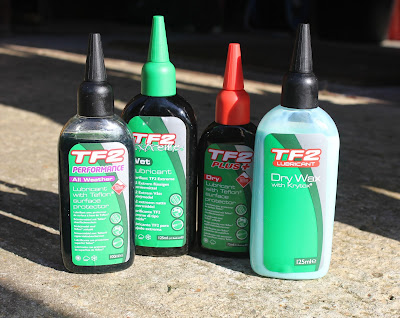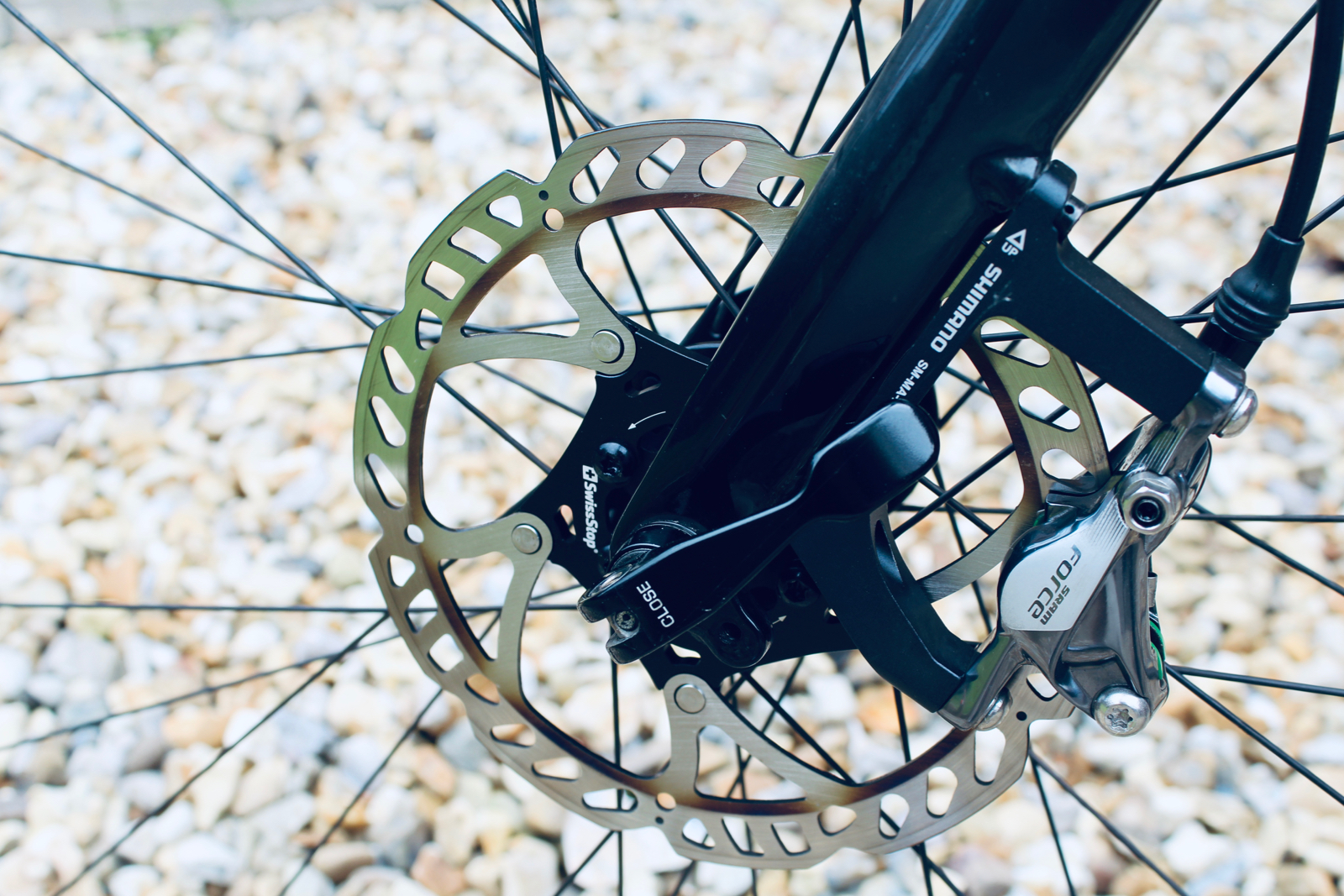Hints and Tips: Maintenance: Choosing Your Chainlube
There are a lot of different chain lubes out there; wet lube, dry lube, wax... the list goes on. In this post I look at four different lubes from Weldtite that I use on my bikes, and explain when is the best time to use each one, and what the benefits of each are.
Firstly though, a little bit of advice on how to apply chain lube...
The first step is to make sure your chain is thoroughly dry, and there is no water left on it or inside it. Pro bike mechanics often use their air compressors to dry the chain, but for most of us that is not a luxury we have to hand; a clean rag coated in some water displacer such as TF2 Aerosol Lubricant is just as effective if you wipe the chain over with it.
Chain lube should then be applied to the INSIDE of the chain, this way the centrifugal forces of the chain moving round mean the lubricant is moved through the chain to the outside as you pedal (rather than being sprayed off the chain if you put it on the outside). To apply chain lube properly you should apply one small drop to each roller on the chain; ideally setting the bike up in a stand and rotating the cranks as you do this. A chain really is only as strong as its weakest link, and you can be sure that one roller you forget to lube will be the one that rusts up and snaps on you. The procedure is a bit of a faff, but is it worth it to have a smooth running drivechain that will last for a longer period of time.
Choosing your chainlube of choice:
TF2 Extreme Wet Lube
First up the Wet Lube; wet lubes are oil based, so they run inside the chain and help to lubricate all parts of the rollers. The TF2 Extreme Wet Lube is made for seriously tough conditions, it goes on like stringy cheese and sticks to the chain even with hours of water blasting it. I've used the TF2 Extreme lube on long touring trips such as my France and Spain trip, and it has kept my chain running smooth. Wet lube is great for long rides, wet rides and times when lighter lubricants are likely to run thin. Use this when things are going to get tough!
TF2 Plus+ Dry Lube with Teflon
Despite what people often seem to think from the name, dry lube is just at home in the wet. Dry lube uses a waxy Teflon layer that coats the chain as a liquid, then dries in place. This has many advantages; firstly it stays put inside the chain where it really matters, keeping the rollers lubricated even when the lube has washed off the outside of the chain. Dry lube also has the advantage that unlike wet lube it does not attract dust or grit, which can make a nasty grinding paste on a chain. This is a great lube to use in all weather then, especially when there is likely to be grit and dust flying up off the road or trail.
TF2 DryWax with Krytox
Use this if things are really going to get bad. Wax lubricant is made to coat the chain with a thick layer of 'hard' lubricant. Wax lube isn't as light on the chain as oil-based lubes and as a result doesn't provide quite the same level of lubrication and friction reduction. However, when your chain is going to get blasted by hours and hours of abuse this will stay in place. The downside is it can be a bit tricky to get off afterwards (post coming soon on bike and chain cleaning).
TF2 Performance All Weather with Teflon
If the above sounds a bit complicated; with different lubes for all different weather conditions, then there is a solution... the All Weather Lube. This is a mix between and oil based and a wax based lube; it will do the job of both. It doesn't attract as much dust as wet lube, but it doesn't wash off either; it's a great compromise between the two choices, and in reality it's what I use the majority of the time on my bikes.
So there you go, a bit about different chain lubes, and which one to choose when you look out the garage window and see the weather. These four lubes from Weldtite are a great option; they are great value, have easy-to-use nozzles and most importantly they work! Look after your chain... it will last longer and be more efficient for it.
Firstly though, a little bit of advice on how to apply chain lube...
The first step is to make sure your chain is thoroughly dry, and there is no water left on it or inside it. Pro bike mechanics often use their air compressors to dry the chain, but for most of us that is not a luxury we have to hand; a clean rag coated in some water displacer such as TF2 Aerosol Lubricant is just as effective if you wipe the chain over with it.
Chain lube should then be applied to the INSIDE of the chain, this way the centrifugal forces of the chain moving round mean the lubricant is moved through the chain to the outside as you pedal (rather than being sprayed off the chain if you put it on the outside). To apply chain lube properly you should apply one small drop to each roller on the chain; ideally setting the bike up in a stand and rotating the cranks as you do this. A chain really is only as strong as its weakest link, and you can be sure that one roller you forget to lube will be the one that rusts up and snaps on you. The procedure is a bit of a faff, but is it worth it to have a smooth running drivechain that will last for a longer period of time.
Choosing your chainlube of choice:
TF2 Extreme Wet Lube
First up the Wet Lube; wet lubes are oil based, so they run inside the chain and help to lubricate all parts of the rollers. The TF2 Extreme Wet Lube is made for seriously tough conditions, it goes on like stringy cheese and sticks to the chain even with hours of water blasting it. I've used the TF2 Extreme lube on long touring trips such as my France and Spain trip, and it has kept my chain running smooth. Wet lube is great for long rides, wet rides and times when lighter lubricants are likely to run thin. Use this when things are going to get tough!
TF2 Plus+ Dry Lube with Teflon
Despite what people often seem to think from the name, dry lube is just at home in the wet. Dry lube uses a waxy Teflon layer that coats the chain as a liquid, then dries in place. This has many advantages; firstly it stays put inside the chain where it really matters, keeping the rollers lubricated even when the lube has washed off the outside of the chain. Dry lube also has the advantage that unlike wet lube it does not attract dust or grit, which can make a nasty grinding paste on a chain. This is a great lube to use in all weather then, especially when there is likely to be grit and dust flying up off the road or trail.
TF2 DryWax with Krytox
Use this if things are really going to get bad. Wax lubricant is made to coat the chain with a thick layer of 'hard' lubricant. Wax lube isn't as light on the chain as oil-based lubes and as a result doesn't provide quite the same level of lubrication and friction reduction. However, when your chain is going to get blasted by hours and hours of abuse this will stay in place. The downside is it can be a bit tricky to get off afterwards (post coming soon on bike and chain cleaning).
TF2 Performance All Weather with Teflon
If the above sounds a bit complicated; with different lubes for all different weather conditions, then there is a solution... the All Weather Lube. This is a mix between and oil based and a wax based lube; it will do the job of both. It doesn't attract as much dust as wet lube, but it doesn't wash off either; it's a great compromise between the two choices, and in reality it's what I use the majority of the time on my bikes.
So there you go, a bit about different chain lubes, and which one to choose when you look out the garage window and see the weather. These four lubes from Weldtite are a great option; they are great value, have easy-to-use nozzles and most importantly they work! Look after your chain... it will last longer and be more efficient for it.





That is very informative, Tim! A proper lubrication is necessary to a drive chain as it affects our riding performance. And even if there are thousands of lubricant products out there, we must choose the one that fits: the shape and style of our bikes, how frequent you ride it and the weather and road condition of the places go with it.
ReplyDeleteRegards,
Tanner =)
This is very helpful.Different chain lubricants are designed for different environments.Wet lubricants are ideal for wet, muddy or snowy conditions when rust is the main concern.
ReplyDeletewww.adsalesltd.com
Is there an expiry date for the tf2 dry wax lube. I have a bottle and it seems the wax and the oil inside the bottle have seperated.. is that safe to use afyer shaking rhe bottle a bit?
ReplyDeleteIt's natural for the contents to separate. Give the bottle a really good shake before using it.
Delete